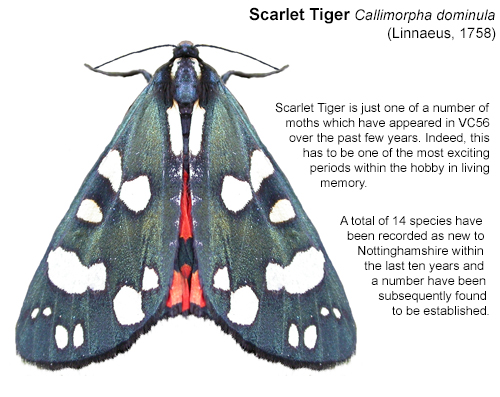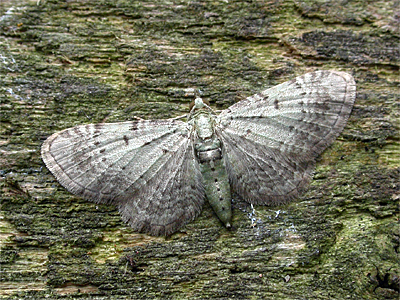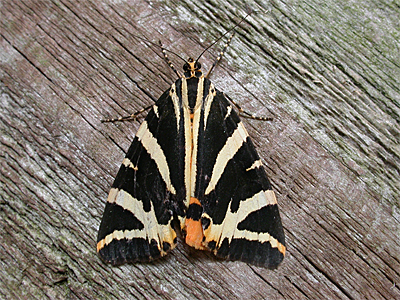

| Nottinghamshire's most recent invertebrate arrivals and colonists |
| No 4. Larger moths |
| We live in what surely has to be the most exciting
period for many decades, in which to have an interest in moths. Whether this new era of a seemingly continuous array of new species being added to county lists, is purely down to the effects of global warming or not, is perhaps open to question and debate. But whatever the cause or the trigger is, for species to begin expanding their UK range after many years being confined to southern and south-eastern counties - as an entomologist, you surely have to welcome it. Whatever hobby or interest we may have, we all crave fresh impetus from time to time and for entomologists, we all crave the addition of new species to our favourite local patch, nature reserve or garden species list. New species provide a stimulus to carry on recording efforts, to keep going through those times when it all gets a bit too predictable. That unpredictability is what keeps us doing what we love and when you first switch the trap on at dusk, you always hope that a few hours later, or maybe the following morning, the trap contains something new and exciting. |
 |
|
| .... | ||
|
Nottinghamshire is geographically
well placed and we are fortunate that those species moving northwards,
will at some time turn up here and being central, are ideally placed for
those occasional wanderers from far off habitats. 2021 saw
Marsh Oblique-barred
Hypenodes humidalis turn
up in a Market Warsop garden, well away from it's favoured acidic
marshland habitat. But there have been similar instances of moths
turning up unexpectedly over the past few years. Several species coming in this category are included in the summaries to follow, but there are other species which aren't mentioned. Moths turning up completely unexpectedly for various reasons, have included both White-marked Cerastis leucographa and Blossom Underwing Orthosia miniosa in 2019 and Light Knot-grass Acronicta menyanthidis in 2020. Who knows what else will turn up, but in the meantime here's a brief summary of all the latest larger moth additions to the Nottinghamshire moth list. |
||
| .... | ||
|
Recent arrivals to Nottinghamshire and
likely colonists Nottinghamshire has experienced (or maybe just beginning to experience) something of a purple patch, with a string of new larger moths being added to the county list over the past few years. Not all of these are perhaps that surprising and would have been predicted to turn up by many, in view of population increases and range expansion showed by a number of species listed below. But what probably will have caught many by surprise, is the number of new species urning up, which if anything is increasing. |
||
| ... | ||
|
The number of people moth trapping and the number of records being sent
to the county recorder is also on the increase. One only has to look at
the annual moth reports produced by Shiela Wright these past few years,
to see how much things have changed from 15 or so years ago. Today's
reports contain far more individual records of many more species than
they used to and it's an exciting time to be moth trapping, especially
in view of the moths turning up, even if these come during what hae been
a couple of poor years in terms of actual numbers of moths. There can be
few people willing to say a species has done really well and the
extremes of our early Spring weather seems once again, to be the cause.
There may be a number of possible causes which trigger range expansion and climate change/global warming will always top the list, but in truth, who ever really knows just why species are suddenly triggered to expand their range and move north after many years? Grey Shoulder-knot (2003) Pale Pinion (2006) Chocolate Tip (2007) and Small Ranunculus (2009) are four species already here after undergoing northward range expansions during the first decade of this century. All have remained to become resident species and look set to stay while conditions remain suitable. |
 |
|
| .... | ||
|
Even those running light traps from urban gardens have had success and
most of those species featured below, have made their way onto the
county list via the garden Actinic or MV light.
Least Carpet Idaea rusticata, Scarlet Tiger Callimorpha
dominula, Jersey Tiger Euplagia quadripunctaria,
The Passenger
Dysgonia algira,
Marsh Oblique-barred
Hypenodes humidalis,
Toadflax Brocade
Calophasia lunula and Tree-lichen Beauty Cryphia
algae are such examples of county firsts from the comfort of home. A note on the county's Broadholme records Broadholme lies directly on the Nottinghamshire border with Lincolnshire and is officially in the vice county of Nottinghamshire (VC56). However, it is not in the administrative county of Nottinghamshire, on which the county's moth records are based by the county macromoth recorder. Because of this, no Broadholme records have ever appeared in any annual county reports, but it should be known that all Broadholme records are recognised by Butterfly Conservation as being valid Nottinghamshire records. |
|
69.008
B&F 1982
Narrow-bordered Bee Hawk-moth Hemaris tityus
(Linnaeus, 1758) |
|||||||||||||||||||||||||||
| Unknown in Nottinghamshire until added to the county list in 2020, when a female was photographed egg-laying on Scabious growing at Ratcher Hill, Mansfield on 25/05/20 (Keywood, B.). | |||||||||||||||||||||||||||
| ... | |||||||||||||||||||||||||||
|
Without doubt, this was a most unexpected record as most counties are reporting a marked decline in the number of records. | ||||||||||||||||||||||||||
| ... | |||||||||||||||||||||||||||
| So against a background of national decline, Narrow-bordered Bee Hawk-moth is recorded in Nottinghamshire for the first time. In view of the rumour that Broad-bordered Bee Hawk-moth has been released somewhere in Nottinghamshire, is the 2020 Narrow-bordered Bee Hawk-moth record of captive origin? | |||||||||||||||||||||||||||
|
70.004 .. B&F 1699 Least
Carpet
Idaea
rusticata
([Denis & Schiffermüller],
1775) |
|||||||||||||||||||||||||||
| Formerly restricted to south-eastern counties of the UK, but suddenly started to spread inland and north through the UK and in the end, it was perhaps surprising that it took so long before it reached Nottinghamshire. It was recorded new to VC56 in 2017, when one was attracted to an MV light at Misterton in the north of the county on 08/07/17 (Lee, P.). Multiple records have since occurred annually following a single at Broadholme on 18/07/18 (Gray, M.). | |||||||||||||||||||||||||||
| ... | |||||||||||||||||||||||||||
|
There were a total of five records of Least Carpet in 2019, although one of these was known not to have been reported to the county recorder. | ||||||||||||||||||||||||||
| ... | |||||||||||||||||||||||||||
|
Records came from Stanton-on-the-Wolds on 02/07/19
(Mathers, S.), Misterton 24/07/19 (Lee, P.) Barnby-in-the-Willow 25/07/19 (Beacock,
O.), Stanton-on-the-Wolds again on 02/08/19 and Bramcote on 02/08/19
(Ellis, I.).
In 2020, there were a further three more records, in addition to one not
sent to the county recorder, but which was photographed. The first was
one at Market Warsop on 25/06/20 (Chick, S.) and there was another from
Misterton 06/07/20 (Lee, P.). Others were trapped at Mansfield on
30/07/20 (Ashley, A. and Morton, D.) and at Ravenshead on 31/07/20
(McGeever, D.). Least Carpet is obviously successfully breeding here and records look set to increase even more as the moth become more widespread. The number of records in 2021, looks set to rise on both 2019 and 2020, with records already reported from Market Warsop (Chick, S.) and Carlton (Adcock, A.). |
|||||||||||||||||||||||||||
|
70.145
... B&F 1861
Bilberry Pug
Pasiphila debiliata (Hübner, [1817])
|
|||||||||||||||||||||||||||
| Bilberry Pug is one of a number of moths recorded new to Nottinghamshire in 2021 and was really recorded by accident. Four larvae found within larval spinnings on Bilberry Vaccinium myrtillus, were collected from Theives Wood near Mansfield and taken home to rear through to adult. Initially suspected as being the larvae of an unknown Tortrix, it was something of a surprise when the first moth emerged late evening on June 6th and was found to be Bilberry Pug. This was followed by a further two adults emerging the following evening and all were released back at the point of collection. | |||||||||||||||||||||||||||
| ... | |||||||||||||||||||||||||||
| Bilberry is a scarce plant in Nottinghamshire, so Bilberry Pug will always have a restricted range here, if it is found at any other site. |
|
||||||||||||||||||||||||||
| .... | |||||||||||||||||||||||||||
| It is highly unlikely that the moth is actually new to the county, but has probably just been overlooked previously. It has not been recorded from the site before, even though trapping sessions have been held there and it's non-appearance may simply be that it is a species not readily attracted to MV light. | |||||||||||||||||||||||||||
|
70.186
... B&F 1841
Yarrow Pug
Eupithecia millefoliata
(Rössler, 1866) |
|||||||||||||||||||||||||
| One attracted to an actinic light in a Mansfield garden on 23/07/20 (Beasley, N.) was the first record for Nottinghamshire. There have been further records from the same site since, with singles to actinic light on 07/07/21 and 13/07/21, but it also turned up in a Carlton garden on 09/07/21 (Adcock, A.). | |||||||||||||||||||||||||
| ... | |||||||||||||||||||||||||
|
|||||||||||||||||||||||||
| ... | |||||||||||||||||||||||||
| Either way, Yarrow Pug has been increasing steadily across southern counties of the UK for a number of years and it is probably already more widespread than records would presently suggest. With Yarrow being a very common plant on many sites, Yarrow Pug is just as likely to occur in urban gardens, as it is more rurally located sites. | |||||||||||||||||||||||||
|
70.264
....
B&F
1940
Satin Beauty
Deileptenia ribeata (Clerck, 1759)
|
|||||||||||||||||||||||||||
| Satin Beauty remains a rare moth in Nottinghamshire, even though it was first recorded in the county from Clumber Park back in 2009 (Woods, R.). The record wasn't deemed to be acceptable at the time and it isn't shown in the table below right, but the record was reviewed and later accepted as genuine by the county recorder, when another was trapped by the same observer and again at Clumber Park in 2011 (Woods, R.). | |||||||||||||||||||||||||||
| ... | |||||||||||||||||||||||||||
| There have been no further reports from Clumber since, although this does not neccessarily mean the moth isn't established there. It probably is, but records from Clumber can take time to filter out. |
|
||||||||||||||||||||||||||
| ... | |||||||||||||||||||||||||||
| In 2019, Satin Beauty was recorded from Centre Parcs on 16/07/19 (Hill, M.) and was recorded on a further five occasions the following year, between 29/06/20 and 21/07/20. It must surely be present at other sites in certain wooded areas between Clumber Park and Centre Parcs, with Rufford CP having to be considered extremely likely to host this moth. | |||||||||||||||||||||||||||
|
72.029
.... B&F 2068
Scarlet Tiger
Callimorpha dominula (Linnaeus, 1758) |
|||||||||||||||||||||||||||
| An adult attracted to MV light at Southwell in July 2015 (Yates, D.) was the first record for Nottinghamshire. A second followed in 2018, when one was found and photographed in a Beeston Garden and showed to staff at Attenborough Nature Reserve (per Sexton, T.). | |||||||||||||||||||||||||||
| ... | |||||||||||||||||||||||||||
|
But there were no further records until two suddenly came within days of each other at Bestwood Village and Carlton in June 2020. | ||||||||||||||||||||||||||
| ... | |||||||||||||||||||||||||||
| Both occurred during a period of hot, humid weather and remarkably, a third record came from Netherfield Lagoons in early July 2020. Moths have since been recorded at Netherfield Lagoons on at least two further occasions in 2021 and appeared to MV light at Market Warsop during the third night of a spell of hot and humid weather with high night time temperatures. Scarlet Tiger is expanding it's range nationally and appears to be colonising Nottinghamshire. Further records are obviously on the way and it would be worth searching for larvae at Trent Valley sites. |
|
72.076
....
B&F 2451 Clifden
Nonpareil Catocala
fraxini (Linnaeus, 1758) |
|||||||||||||||||||||||||||
| Once only known in the UK as a scarce and much sought-after migrant to southern coastal counties from the near Continent, an increase in records over the past ten years or so, saw it become established in some southern counties, with a number of sites (even well inland) recording adults on an annual basis. Nottinghamshire's first record came when one was attracted to MV light at the Idle Valley NR on 06/09/17 (Hunt, I. and Cadman, P.). | |||||||||||||||||||||||||||
| ... | |||||||||||||||||||||||||||
| There has recently been a second record of one at Stanton-on-the-Wolds in the south of the county on 28/09/20 (Mathers, S). |
|
||||||||||||||||||||||||||
|
73.059
....
B&F 2223
Toadflax Brocade
Calophasia lunula
(Hufnagel, 1766)
|
|||||||||||||||||||||||||||
| Recorded as new to Nottinghamshire in 2015, when recorded to MV light at Keyworth (Pinder, N.). This first Nottinghamshire record come after the moth had dramatically increased it's UK range, after formally being confined to the Dungeness area of Kent for many years. | |||||||||||||||||||||||||||
| ... | |||||||||||||||||||||||||||
|
There were no other records until 2020, including adults at West Bridgford on 26/05/20 ( Hurst, A.) and then at Beeston in August (Sexton, T.). | ||||||||||||||||||||||||||
| ... | |||||||||||||||||||||||||||
| A number of records featurning larvae came in the late Summer/early Autumn of 2020, from East Leake on 31/08/20 (Stock, D.) Gotham 05/09/20 (Stock, D.) East Leake on 08/09/20 (Stock, D.) and East Leake on 28/09/20 (Murray, G. per Butterfly Conservation) and there have already been further records from south Nottinghamshire in 2021. | |||||||||||||||||||||||||||
|
73.082
....
B&F 2292
Tree-lichen Beauty
Cryphia algae (Fabricius, 1775)
|
|||||||||||||||||||||||||||
| Still regarded as largely being migratory to the UK, but now increasing in numbers and is thought likely to have become established in some south-eastern counties. It was recorded new to Nottinghamshire in 2018, when one was trapped at Carlton on 2707/18 (Adcock, A.) and this will almost certainly lead to many more over the next decade or so. | |||||||||||||||||||||||||||
| ... | |||||||||||||||||||||||||||
|
There were no Nottinghamshire records in 2019, when more were perhaps expected, but there was evidence of a continued range expansion with numerous records from neighbouring counties. | ||||||||||||||||||||||||||
| ... | |||||||||||||||||||||||||||
| It wasn't until 2020 that there were further records, including three recorded at West Bridgford between 05/08/20 and 07/08/20 (Freestone, R.), two to LED light at Radcliffe-on-Trent on 08/08/20 (Dulwich, P.) and singles to MV light at Budby Pumping Station on 09/08/20 (Morton, D. and Ashley, A.) and near Bestwood (Carlyle, R. and Carlyle, J.) on the same night. | |||||||||||||||||||||||||||
|
73.151
.... B&F 2373
Webb's Wainscot
Globia sparganii (Esper, 1789) |
|||||||||||||||||||||||||||
| Known from three Nottinghamshire sites after being recorded in VC56 for the first time in 2016, with records from Besthorpe GP on 05/09/16 (Wright, S. and Osborne, J.) and Broadholme (Gray, M.) on the county border with Lincolnshire on 02/08/18. | |||||||||||||||||||||||||||
| ... | |||||||||||||||||||||||||||
|
The most recent Nottinghamshire record is from Misterton in the north of the county, with a single trapped on 22/08/20 (Lee, P.). | ||||||||||||||||||||||||||
| ... | |||||||||||||||||||||||||||
| Three records from a county it was unrecorded from before 2016, would suggest that Webb's Wainscot is currently expanding it's UK range and records from the neighbouring county of Leicestershire would seem to agree with this, as there has been an increase in records of the moth there across the same time period (per NBN Atlas). | |||||||||||||||||||||||||||
| Moths recently recorded new to Nottinghamshire but not considered likely colonisers | ||
| .......................................................................................................... | ||
| 72.030 ... 2067 ...
Euplagia quadripunctaria
Jersey
Tiger This was a huge surprise when one
appeared at MV light in a Worksop garden on 05/08/20 (Cadman, P.).
Having a species like Jersey Tiger turn up in a north Nottinghamshire town, no doubt raised a few eyebrows at the time and there may well have been some people questioning the credibility of it's origin on hearing the news. But this moth turned up along with numerous other records involving unexpected species at other Midland sites and any doubts about it's crediility were ended, when news broke of The Passenger Dysgonia algira being trapped at Misterton (Lee, P.) the following day. 72.060 ... 2485 ... Hypenodes humidalis Marsh Oblique-barred A surprising addition to the Nottinghamshire fauna, when one was attracted to an MV light run in a Market Warsop garden on July 21st 2021. The record came after nearly a week of hot humid weather, usually condusive to species known to have wandering tendancies turning up. This is one of the smallest examples of UK macrolepidoptera with a wingspan of around 15mm, which equates to about the same size as Eudonia mercurella (Scopariinae) and indeed, this moth could be mistaken for being just another worn micro. |
 |
|
| ... | ||
| 72.087 ... 2460 ...
Dysgonia algira
The Passenger A single attracted to MV light at
Misterton (Lee, P.) is Nottinghamshire's only record, occurring during a
period of very hot and humid weather and coinciding with migrant
activity into southern parts of the UK. 74.002 ... 2076 ... Meganola albula Kent Black Arches The first record for Nottinghamshire and was trapped by members of the Lound Moth Group at the Idle Valley NR on August 2nd 2019 (Hunt, I. Newman, M. and Cadman, P.). |
||